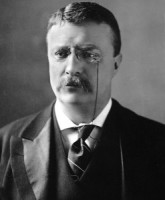
I suppose whether you think Teddy Roosevelt was a great president depends on your politics, but it would be hard to argue that he was not a successful leader.
In 1902, Roosevelt was searching for a way to end a long-running coal strike without taking extra-constitutional (quite possibly unconstitutional) action. He was being urged variously to send in federal troops to break the strike, or to send in the same troops to seize the mines from the operators. He had finally gotten both sides to agree to a temporary halt in the strike with a commission appointed to settle the dispute.
The mine operators were holding firm that this commission could not include a labor leader, lest that be construed as recognition of the miner’s union. Unsurprisingly, the miner’s union was holding just as firm that a labor leader must be on the commission.
With a flash of insight, Roosevelt suggested that he would appoint E.E. Clark, the head of the railway conductors’ union, to the commission as an “eminent sociologist”, which was acceptable to the operators.
In his own words “I at last grasped the fact that the mighty brains of these captains of industry had formulated the theory that they would rather have anarchy than tweedledum, but if I would use the word tweedledee they would hail it as meaning peace.”
A great reminder that words matter. Sometimes finding a small face-saving gesture — even a better label for the same truth — can get everyone to the table. In this case, Roosevelt found a way to end a months-long standoff that had sent coal prices skyrocketing without having to send in federal troops.
Category: Inspiration
Inspiration: “Sorry, I’m busy. Can you go Google it?”
Ignoring the blatant Intel advertising (yay “public” television/radio), this is a great story- kid asks his parents how blind people read, they blow him off, and he ends up building a braille printer out of Legos.
Maybe I’m just a lifelong geek, but I love the idea of prototyping with Legos. For those who are would like to build their, the plans for the Braigo printer are on Make’s site. While I get the point that the Lego prototype is not usable by the blind, I’m personally less thrilled with the solution of turning this into a significantly expensive product than I am charmed with the cheap simplicity of the original creation.
I’m currently reading The Peripheral by William Gibson which, among many other things, includes the idea of micro-fabs running sophisticated 3d printers, capable of “printing” electronics like phones. I immediately connected that concept to this project. As cool as Lego prototyping is, imagine what 3d printer based micro-fabs could do for accessibility as specialized types of devices can be assembled from printed pieces at local businesses or in the home (specialized products for the blind currently tend to be wildly expensive because of the limited market). I wonder, as 3d printers improve and can use different materials, if they could be used to assemble circuit boards. If so, then Gibson’s vision in the book might prove to be as close to real as his vision of the internet in Neuromancer.